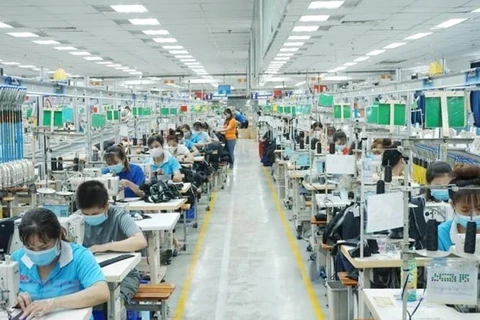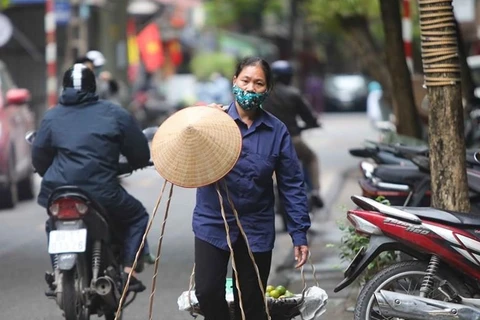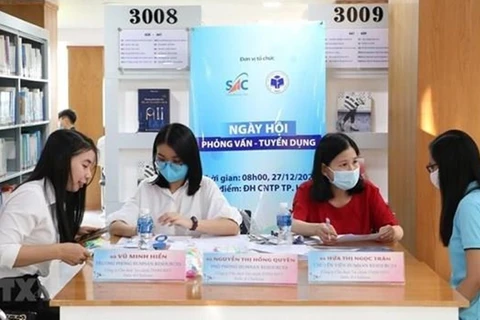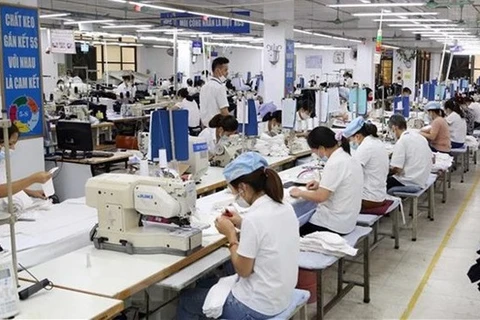Hanoi (VNA) - The flexibly adaptable economy, which will recover in 2022, is forecast to make the Vietnamese labour market thrive, towards achieving the goals regarding labour, employment and social security.
The Government's policy of flexible adaptation to the COVID-19 pandemic has helped improve production and business activities, resulting in the recovery of the labour market.
Positive signals
Despite a serious crisis in 2021, according to experts, with the Government's flexible adaptation solutions, the labour market in 2022 will quickly recover.
Assoc. Prof. Dr. Nguyen Thi Lan Huong, former Director of the Institute of Science, Labour and Social Affairs under the Ministry of Labour, Invalids and Social Affairs, said that the COVID-19 forced workers to stop working. However, the Government has flexibly re-opened factories and businesses so they will have many job opportunities again.
Mentioning the positive signs of the labour market in the coming time, Vu Quang Thanh, Deputy Director of the Hanoi Centre for Employment Services, said that the safe and flexible adaptation policy is helping the labour market gradually recover.
According to Thanh, recruitment demand is on the rise, especially at the beginning of 2022. There is a huge demand for production worker positions at this time, mainly in such fields as apparel, electricity, electronics, goods delivery, trade and services, wholesale and retail...
In Ho Chi Minh City, in 2022, businesses and factories will need an additional 310,000 employees, mainly in the trade-service sector, which accounts for more than 65 percent of the total demand this year.
According to the Center of Forecasting Manpower Needs and Labour Market Information HCMC (Falmi), if COVID-19 is controlled, businesses in the city will need to recruit 280,000-310,000 workers, including nearly 87,000 for the first quarter, over 72,000 for the second quarter, nearly 74,000 for the third quarter and about 77,000 for the fourth.
Navigos' forecast also gives positive signals about recruitment in 2022 when many large enterprises in the electronics industry continue to invest or expand production in Vietnam. Bac Ninh, Hai Phong, Bac Giang, Thanh Hoa and Da Nang continue to receive huge investments from these FDI projects.
Assessing the recovery trend in the coming time, Assoc. Prof. Dr. Vu Quang Tho, former Director of the Institute of Workers and Trade Unions under the Vietnam General Confederation of Labour, said that jobs for manual workers who were hardest hit by the pandemic will see a fast recovery this year.
Avoiding labour supply disruption
Vu Trong Binh, Director of the Employment Department under the Ministry of Labour, Invalids and Social Affairs, said that 2022 is an important year, creating a foundation for realizing the objectives of the 2021-2025 plan. Economic recovery will boost Vietnam's labour market, towards achieving goals on labour, employment and social security. However, the COVID-19 can become complicated in some areas, challenging the recovery and development of the labour market.
According to Binh, it is forecast that in 2022, even with the best scenario (the epidemic is basically controlled and the vaccination rate meets the set target by the end of the first quarter), the COVID-19 pandemic will continue to negatively impact more than 5 million workers.
"There is still an imbalance of labour supply and demand in some sectors and a shortage of workers in the key economic regions in the South," he said.
In that context, Minister of Labour, Invalids and Social Affairs Dao Ngoc Dung emphasized that perfecting institutions and supporting the recovery and development of the labour market and employment is one of the top priority tasks to restore the economy in the coming period. The ministry set the targets of maintaining the labour force, especially in industrial parks, export processing zones and growth hubs; strengthening measures to retain existing employees, thus avoiding any disruption in the supply of human sources for enterprises’ production and business; and supporting workers to get loans.
The ministry has also targeted the unemployment rate at below 4 percent in urban areas and less than 2 percent in rural areas.
To achieve these goals, policies to support employees working in enterprises in key economic regions and localities with economic zones, industrial parks and high-tech parks are needed.
In addition, localities will promptly establish information and data systems to serve labour supply-demand connection; create an environment and conditions for employees as well as employers to meet and exchange information on labour and employment in 2022./.

























